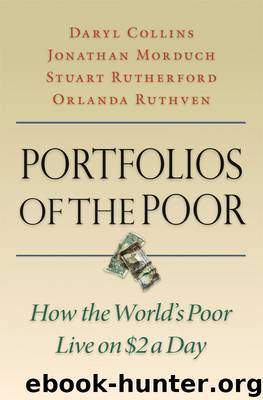Portfolios of the Poor by Daryl Collins & Jonathan Morduch & Stuart Rutherford & Orlanda Ruthven

Author:Daryl Collins & Jonathan Morduch & Stuart Rutherford & Orlanda Ruthven
Language: eng
Format: epub
Publisher: Princeton University Press
Published: 2009-09-20T16:00:00+00:00
Chapter Five
THE PRICE OF MONEY
IN THE SPRING of 2007, the Mexican microfinance bank Banco Compartamos completed a highly successful public offering of its stock. Inspired by Grameen Bank, Compartamos had grown rapidly while keeping its focus on a customer base of low-income women. By 2008, Compartamos served over one million customers, using its profits to fuel expansion. In some corners, this was cause for celebration, a vindication of the commercial possibilities of banking in poor communities. But for others the success story was marred by the high interest rates that Compartamos charged its customers. A widely read study reported that, on average, Compartamos’s interest rates exceeded 100 percent per year. Of that, customers paid 15 percentage points to value-added taxes, 24 percentage points went to profits, and the rest covered the basic costs of making loans.1
Muhammad Yunus, the founder of Grameen Bank, was outraged. His concern aligns with the broadly felt sense that programs for the poor should not take advantage of customers’ vulnerability and lack of options. Moneylenders may charge 100 percent per year or more, critics like Yunus argue, but microfinance institutions are not moneylenders. Yet Grameen Bank, like its competitors, does not give away its services for free. It aims to charge reasonable prices for reliable services. In South Asia, interest rates tend to vary between 20 and 40 percent per year, well below the rates charged by Compartamos but well above giveaway levels. A study of nearly 350 microfinance institutions worldwide found that, after taking inflation into account, interest rates generally fall between 10 percent and 35 percent per year—again well below the interest rates of Compartamos.
Still, the same study found that those institutions serving the poorest customers face the highest costs of lending. Finance for the poor means dealing with lots of small loans and, when savings services are on offer, many small deposits. For providers, small-sized transactions mean limited scale economies and thus high costs per transaction. Out of necessity, “pro-poor” microfinance institutions tend to charge the highest interest rates of all; microfinance banks serving better-off customers tend to charge the least. Even if Compartamos had earned no profit and paid no taxes, their interest rates would have still had to be 60 percent per year to cover costs of their strategy for small-scale lending in Mexican villages and towns.2
Examples from the diaries confirm that interest rates on financial services for the poor can be very high. In South Africa, most moneylender rates run at about 30 percent per month. Even the Small Enterprise Foundation (SEF), a microfinance institution in South Africa with a long-term commitment to serving the rural poor in Limpopo Province, charges an effective interest rate of about 75 percent per year on its loans, but barely covers its costs after paying its staff and accounting for its own capital costs. Interest rates this high sound usurious, perhaps, but borrowers report that local moneylenders, who charge much more, will only lend them much smaller amounts of money. If it were forced
Download
This site does not store any files on its server. We only index and link to content provided by other sites. Please contact the content providers to delete copyright contents if any and email us, we'll remove relevant links or contents immediately.
Cecilia; Or, Memoirs of an Heiress — Volume 1 by Fanny Burney(32434)
Cecilia; Or, Memoirs of an Heiress — Volume 2 by Fanny Burney(31869)
Cecilia; Or, Memoirs of an Heiress — Volume 3 by Fanny Burney(31852)
The Great Music City by Andrea Baker(31335)
We're Going to Need More Wine by Gabrielle Union(18967)
All the Missing Girls by Megan Miranda(15564)
Pimp by Iceberg Slim(14387)
Bombshells: Glamour Girls of a Lifetime by Sullivan Steve(13972)
Talking to Strangers by Malcolm Gladwell(13222)
Norse Mythology by Gaiman Neil(13204)
Fifty Shades Freed by E L James(13157)
For the Love of Europe by Rick Steves(12938)
Mindhunter: Inside the FBI's Elite Serial Crime Unit by John E. Douglas & Mark Olshaker(9192)
Crazy Rich Asians by Kevin Kwan(9167)
The Lost Art of Listening by Michael P. Nichols(7403)
Enlightenment Now: The Case for Reason, Science, Humanism, and Progress by Steven Pinker(7228)
The Four Agreements by Don Miguel Ruiz(6627)
Bad Blood by John Carreyrou(6548)
Weapons of Math Destruction by Cathy O'Neil(6142)
